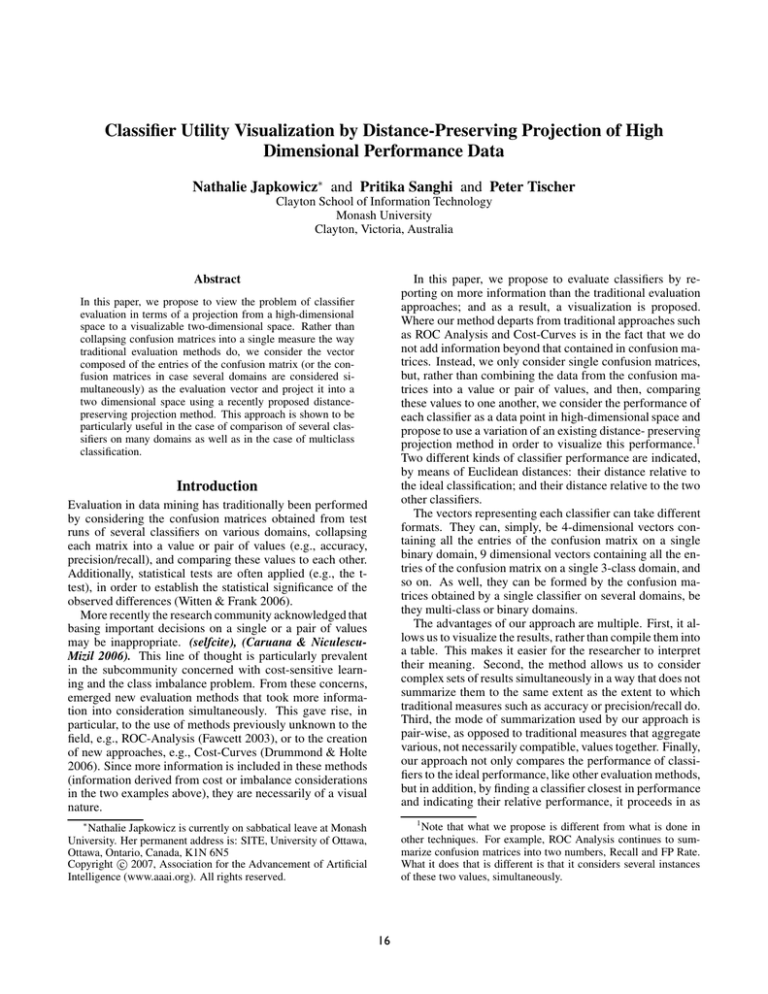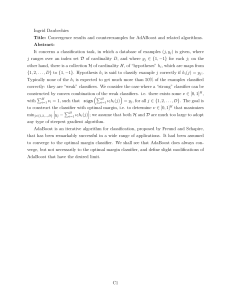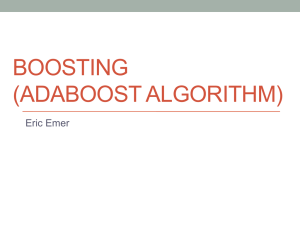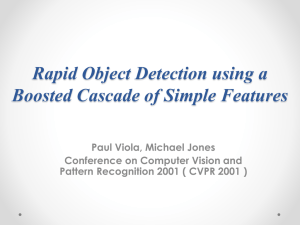
Classifier Utility Visualization by Distance-Preserving Projection of High
Dimensional Performance Data
Nathalie Japkowicz∗ and Pritika Sanghi and Peter Tischer
Clayton School of Information Technology
Monash University
Clayton, Victoria, Australia
Abstract
In this paper, we propose to evaluate classifiers by reporting on more information than the traditional evaluation
approaches; and as a result, a visualization is proposed.
Where our method departs from traditional approaches such
as ROC Analysis and Cost-Curves is in the fact that we do
not add information beyond that contained in confusion matrices. Instead, we only consider single confusion matrices,
but, rather than combining the data from the confusion matrices into a value or pair of values, and then, comparing
these values to one another, we consider the performance of
each classifier as a data point in high-dimensional space and
propose to use a variation of an existing distance- preserving
projection method in order to visualize this performance.1
Two different kinds of classifier performance are indicated,
by means of Euclidean distances: their distance relative to
the ideal classification; and their distance relative to the two
other classifiers.
The vectors representing each classifier can take different
formats. They can, simply, be 4-dimensional vectors containing all the entries of the confusion matrix on a single
binary domain, 9 dimensional vectors containing all the entries of the confusion matrix on a single 3-class domain, and
so on. As well, they can be formed by the confusion matrices obtained by a single classifier on several domains, be
they multi-class or binary domains.
The advantages of our approach are multiple. First, it allows us to visualize the results, rather than compile them into
a table. This makes it easier for the researcher to interpret
their meaning. Second, the method allows us to consider
complex sets of results simultaneously in a way that does not
summarize them to the same extent as the extent to which
traditional measures such as accuracy or precision/recall do.
Third, the mode of summarization used by our approach is
pair-wise, as opposed to traditional measures that aggregate
various, not necessarily compatible, values together. Finally,
our approach not only compares the performance of classifiers to the ideal performance, like other evaluation methods,
but in addition, by finding a classifier closest in performance
and indicating their relative performance, it proceeds in as
In this paper, we propose to view the problem of classifier
evaluation in terms of a projection from a high-dimensional
space to a visualizable two-dimensional space. Rather than
collapsing confusion matrices into a single measure the way
traditional evaluation methods do, we consider the vector
composed of the entries of the confusion matrix (or the confusion matrices in case several domains are considered simultaneously) as the evaluation vector and project it into a
two dimensional space using a recently proposed distancepreserving projection method. This approach is shown to be
particularly useful in the case of comparison of several classifiers on many domains as well as in the case of multiclass
classification.
Introduction
Evaluation in data mining has traditionally been performed
by considering the confusion matrices obtained from test
runs of several classifiers on various domains, collapsing
each matrix into a value or pair of values (e.g., accuracy,
precision/recall), and comparing these values to each other.
Additionally, statistical tests are often applied (e.g., the ttest), in order to establish the statistical significance of the
observed differences (Witten & Frank 2006).
More recently the research community acknowledged that
basing important decisions on a single or a pair of values
may be inappropriate. (selfcite), (Caruana & NiculescuMizil 2006). This line of thought is particularly prevalent
in the subcommunity concerned with cost-sensitive learning and the class imbalance problem. From these concerns,
emerged new evaluation methods that took more information into consideration simultaneously. This gave rise, in
particular, to the use of methods previously unknown to the
field, e.g., ROC-Analysis (Fawcett 2003), or to the creation
of new approaches, e.g., Cost-Curves (Drummond & Holte
2006). Since more information is included in these methods
(information derived from cost or imbalance considerations
in the two examples above), they are necessarily of a visual
nature.
1
Note that what we propose is different from what is done in
other techniques. For example, ROC Analysis continues to summarize confusion matrices into two numbers, Recall and FP Rate.
What it does that is different is that it considers several instances
of these two values, simultaneously.
∗
Nathalie Japkowicz is currently on sabbatical leave at Monash
University. Her permanent address is: SITE, University of Ottawa,
Ottawa, Ontario, Canada, K1N 6N5
c 2007, Association for the Advancement of Artificial
Copyright Intelligence (www.aaai.org). All rights reserved.
16
way that can be quite useful for understanding the innerworkings of relative sets of classifiers or to identify classifiers that do not behave similarly to other systems.
The remainder of the paper is organized as follows: Section 2 describes the proposed projection method. Section 3
shows how this method fares on the simplest types of domains, binary ones, when considered on each domain separately. Section 4 extends our study to the case where classifiers are compared on several domains simultaneously. and
Section 5 considers the case of multi-class problems. In both
sections, we underly the particular advantages of our technique. Section 6 concludes the paper and points to possible
future work.
measures on a classification domain taken from the UCI
Repository of Machine Learning: Breast Cancer. Specifically, we study these performance measures when using 8
different classifiers: Naive Bayes (NB), C4.5 (J48), Nearest
Neighbour (Ibk), Ripper (JRip), Support Vector Machines
(SMO), Bagging (Bagging), Adaboost (Adaboost) and Random Forests (RandFor). All our experiments were conducted using Weka and these particular algorithms were chosen because they each represent simple and well-used prototypes of their particular categories.2 We evaluated the algorithms using 10-fold stratified cross-validation.
The purpose of these preliminary experiments is to test
our approach on relatively simple domains for which the existing traditional evaluation approaches are a good indication of the performance of the classifiers. In all the experiments of this section, the high dimensional space considered has four dimensions, the four entries of the confusion
matrices. After we will have convinced ourselves that the
approach is acceptable and understood how to interpret its
results, we will study its outcome in more complex situations. The results obtained on the Breast Cancer domain
when using the traditional evaluation measures (Accuracy
(Acc), True Positive Rate (TP), False Positive Rate (FP),
Precision (Prec), Recall (Rec), F-Measure (F) and the Area
Under the ROC Curve (AUC) are displayed in Table 1. The
graph obtained using our new measure is shown in Figure 1
and its companion table entitled ”Breast Cancer Projection
Legend”. Table 2 compares the ranking of classifiers obtained by the traditional measures and our measure, respectively. We rank classifiers in terms of the distance between
their classification matrix and the classification matrix of the
ideal and neighbouring classifiers.
Projection Approach
Our approach is a variation on an approach by (Lee, Slagle,
& Blum 1977; Yang 2004). It is described as follows:
Let d(x, y) represent the distance between x and y in the
original higher dimensional space; let P (x) and P (y) be the
projections of x and y onto the two-dimensional space; and
let d2 (P (x), P (y)) represent the distance between the projected points in a two-dimensional space. In this case, we
are projecting the performance of the classifiers, ci where
i = 1, 2, . . . n. We introduce the ideal classifier as p0 . p0 is
mapped to the origin.
Find the classifier which is closest to ideal, p1 , and put
this on the y-axis at (0, d(p0 , p1 )).
For the remaining classifiers, at each stage we find the
classifier, pi , which is nearest to the classifier which has just
been plotted, pi−1 . When plotting pi we want to preserve
two constraints:
d2 (P (pi ), P (pi−1 )) = d(pi , pi−1 )
(1)
i.e. we want the projections of pi and pi−1 to be the same
distance apart as pi and pi−1 .
We also want to satisfy the second constraint:
d2 (P (pi ), P (p0 )) = d(pi , p0 )
NB
J48
Ibk
JRip
SMO
Bagging
Adaboost
RandFor
(2)
i.e. we want the projection of the ideal classifier and the
projection of pi to be the same distance apart as the classifiers are. This means that in the projected space the distance
from the origin is a measure of how close the classifier is to
ideal. The better the classifier, the closer its projection will
be to the origin.
Most times there will be two possible positions for P (pi )
which satisfy both constraints. When there is a choice of
solutions, the solution is chosen to satisfy a third constraint
as closely as possible:
d2 (P (pi ), P (pi−2 )) = d(pi , pi−2 )
Acc
71.7
75.5
72.4
71
69.6
67.8
70.3
69.23
TP
.44
.27
.32
.37
.33
.17
.42
.33
FP
.16
.04
.1
.14
.15
.1
.18
.15
Prec
.53
.74
.56
.52
.48
.4
.5
.48
Rec
.44
.27
.32
.37
.33
.17
.42
.33
F
.48
.4
.41
.43
.39
.23
.46
.39
AUC
.7
.59
.63
.6
.59
.63
.7
.63
Table 1: Breast Cancer - Traditional measures
Table 2 shows that the results we obtained are believable
since they have enough in common with AUC and the Fmeasure, two quite reliable evaluation metrics in the case of
binary classification. Conversely, please note the contrast
between the ranking obtained using accuracy, a less reliable
performance measure, and the other three measures, including ours. In addition to what the other measures do, our
measure indicates which classifiers are close to each other
in performance. Figure 1 shows that the performance for
Adaboost and NB is quite similar on this problem. Another
(3)
The distance measure currently used in this algorithm is
the Euclidean distance.
Experiments on Single Binary Domains using
Confusion Matrices
2
As the purpose of the experiment was to interpret the results
produced by our evaluation method and not to optimize performance, default settings of Weka were used.
In this section, we compare the information provided by our
measure to the information given by traditional evaluation
17
Ranking
1st
2nd
3rd
4th
5th
6th
7th
8th
Accuracy
J48
Ibk
NB
JRip
Adaboost
SMO
RandFor
Bagging
AUC
NB (tie1)
Adaboost (tie1)
Ibk(tie1)
Bagging (tie2)
RandFor (tie2)
JRip
SMO (tie3)
J48 (tie3)
F
NB
Adaboost
JRip
Ibk
J48
SMO (tie1)
RandFor (tie1)
Bagging
Distance CM
NB (tie1)
Adaboost (tie1)
JRip
SMO (tie2)
RandFor (tie2)
Ibk
Bagging
J48
Distance All Data
J48
JRip (tie1)
Adaboost (tie1)
SMO (tie1)
NB (tie1)
RandFor (tie1)
Ibk (tie1)
Bagging
Table 2: Ranking by Accuracy, AUC, F-measure and Our Approach
tries each) into a two dimensional domain. The results of
our approach are presented in Figure 2 and its companion
table entitled“Three Binary Domains Projection Legend”.
Figure 1: Projection of the results on a BinaryClass domain:
Breast Cancer
Classifier
number
1
2
3
4
5
6
7
8
9
Breast Cancer Projection Legend
Classifier Distance
Distance from
name
from origin previous classifier
Ideal
NB
101
Adaboost 101
5
JRip
108
12
SMO
111
5
RandFor
111
1
Ibk
116
14
Bagging
129
18
J48
127
22
Figure 2: Projection of Three Binary Domains
Three Binary Domains Projection Legend
Classifier Classifier Distance
Distance from
number
name
from origin previous classifier
1
Ideal
2
RandFor
154
3
Ibk
173
26
4
JRip
167
37
5
Adaboost 160
16
6
Bagging
166
44
7
J48
170
26
8
SMO
232
126
9
NB
203
230
cluster is formed by SMO, JRip and RandFor; Ibk stands
by itself while Bagging and J48 are closely related. In this
particular case, given that the relative distances within the
clusters are not much higher than the distances between clusters, especially, relative to the distances to ideal, we do not
believe that the clustering information is that meaningful.
However, the next section will present cases where it is.
The results are quite interesting: they show that all the
methods, except for SMO and NB, fall within the range of
generally acceptable approaches. SMO and NB produce
much worse results and are shown to behave very differently from one another as well, since they are not clustered
together. To better understand the graph, we consider this
result in view of the results obtained by the traditional measures of performance that are displayed in Table 3, for the
three domains considered.
This comparison tells us something interesting: SMO
fails quite miserably according to all three measures (Ac-
Experiments on Multiple Binary Domains
In this part of the paper, we experiment with the use of our
approach on multiple domains. Like in the previous section,
we use the Breast Cancer data set, to which we add two UCI
binary data sets: Labour and Liver. This means that we are
projecting vectors of size 12 (3 confusion matrices of 4 en-
18
NB
BC:
La:
Li:
J48
BC:
La:
Li:
Ibk
BC:
La:
Li:
JRip
BC:
La:
Li:
SMO
BC:
La:
Li:
Bagging BC:
La:
Li:
Adaboost BC:
La:
Li:
RandFor BC:
La:
Li:
Accuracy
71.7
89.5
55.4
77.5
73.7
68.7
72.4
82.5
62.9
71
77.2
64.6
69.6
89.5
58.3
67.8
86
71
70.3
87.7
66.1
69.23
87.7
69
F-Measure
.48
.92
.6
.4
.79
.59
.41
.86
.56
.43
.83
.53
.39
.92
.014
.23
.9
.624
.46
.91
.534
.39
.91
.64
AUC
.7
.97
.64
.59
.7
.67
.63
.82
.63
.6
.78
.65
.59
.87
.5
.63
.88
.73
.7
.87
.68
.63
.9
.74
we also looked at results using five rather than three domains. To the three domains previously considered, we
added the following two: Anneal and Contact Lenses, both
from the UCI Irvine Repository for Machine Learning, as
well. These two domains are slightly different from the
other three since they are multi-class domains. In fact, one
of them—Anneal—will be studied individually in the following section in order to illustrate the behaviour of our
method on a multi-class domain. For this section, however,
please note that the kind of aggregating that we are performing would be meaningless if we were to average the results
of the five domains since accuracy in a binary domain has
a different meaning from accuracy in a multiclass domain.
Furthermore, neither the F-measure nor the AUC would be
meaningful in a multiclass situation.
The results are presented in Figure 3:
Table 3: Performance by Traditional Measures on the Breast
Cancer (BC), Labour (La) and Liver (Li) domains.
curacy, F-measure and AUC) on the Liver data set. NB, on
the other hand, only fails badly when accuracy is considered. The F-Measure and AUC do not pick up on the problem. This means that, unless accuracy was considered—
a measure that is gradually becoming least trusted by data
mining researchers—we could not have detected the problem encountered by NB on the Liver data set. In contrast,
our method identified both the problems with NB and SMO
and stated that they were of a different nature. Our method
seems to warn us that these two classifiers are sometimes
unreliable, whereas the other systems are more stable.
Please note that SMO’s problem is something that would
not have been picked up (except possibly if the F-measure
had been considered) by an averaging of performance on all
domains since SMO gets averages of: 72.46% in accuracy,
.44 in F-measure and .65 in AUC versus 74.7% accuracy, .64
in F-measure and .75 in AUC, for Adaboost, quite a good
classifier on these domains. Once its performance results
averaged, NB would not have exhibited any problem whatsoever, no matter which traditional evaluation method were
considered. Indeed, it produced averages of: 72.2% for accuracy, .67 for the F-measure, and .77 for the AUC. Once
again, what is remarkable about our visualization approach
is that the graph of Figure 2 tells us immediately that an
abnormal situation has been detected with respect to SMO
and NB and that this problem is of a different nature in each
case. It does not tells us what the problem is, but it warns us
of that problem in a quite effective way.
To further study the behaviour of our evaluation method,
Figure 3: Projection of the results obtained on 5 domains
Classifier
number
1
2
3
4
5
6
7
8
9
5 Domains Projection Legend
Classifier Distance
Distance from
name
from origin previous classifier
Ideal
RandFor
154
Ibk
173
27
JRip
167
38
J48
170
36
Bagging
166
27
SMO
233
130
Adaboost 220
181
NB
252
248
Here again, we are alerted of problems—lack of
stability—with SMO, NB and Adaboost. This is quite interesting, actually, since these three classifiers are often considered quite strong. Our approach warns that although they
may be strong on some domains, they can also be quite detrimental on others. This means that if someone is looking at
selecting a single general classifier with acceptable classification performance on all domains, they should keep away
from SMO, NB and, this time, Adaboost. If however, one
is looking for the best classifier on a particular domain, it
is possible that SMO, Adaboost or NB be the classifier of
19
choice (as it is known that they are on Text Classification
Domains (Sebastiani 2002)).
Classifier
number
1
2
3
4
5
6
7
8
9
Experiments on Single MultiClass Domains
using Confusion Matrices
In this last section, we consider how our approach fares on
multiclass domains. In particular, we consider the Anneal
domain from UCI. Anneal is a 6-class domain (though one
of the classes is represented by no data point). The data set
is quite imbalanced since the classes contain 684, 99, 67, 40,
8 and 0 instances, respectively. The results obtained on this
domain are displayed in Figure 4 along with the companion
table entitled “Anneal Projection Legend”. Once again, the
graph encourages us to beware of NB and Adaboost, though
it also shows us that Adaboost and NB’s problems are not
related. We compare the results of Figure 4 to the accuracy
results obtained on this domain, displayed in Table 4.
While the accuracies (the only simple compact measure
that can be used in multi-class domains) suggest that NB
and Adaboost do not classify the data as well as the other
domains, it does not alert us of the seriousness of the problem to the same extent that our approach does. Indeed, while
it is true that NB’s accuracy of 86.3% is comparatively much
lower than SMO’s accuracy of 97.4%, because in and of itself 86.3% is not a bad accuracy on a 6-class problem, it is
conceivable that if a user had a specific interest in using NB
rather than SMO or any other good method, s/he could decide that the tradeoff in accuracy is not worth a switch to a
classifier other than NB since NB’s accuracy is good enough
for his/her particular application. This is quite different from
the story painted in Figure 4 in which SMO and Adaboost
are exaggeratedly far from the ideal in comparison to the
other classifiers.
Anneal Projection Legend
Classifier Distance
Distance from
name
from origin previous classifier
Ideal
RandFor
5
Ibk
7
4
J48
12
6
JRip
12
6
Bagging
13
3
SMO
20
11
NB
148
139
Adaboost 151
211
Figure 5: The confusion matrices for Adaboost and NB
curately, except for the two largest classes. We do not have
space here to include the confusion matrices of the other
methods, but we can report that they all did quite a good
job on all classes. In effect this means that all the classifiers
but NB and Adaboost are able to deal with the class imbalance problem, and that NB and Adaboost both behave badly
on this domain, although they do so in different ways. This
is exactly what the graph of Figure 4 tells us. The accuracy
results do suggest that NB and Adaboost have problems, but
they do not differentiate between the two kind of problems.
Furthermore, as discussed earlier the overall accuracy of the
NB and Adaboost classifiers is not drastically worse than
other classifiers.
Figure 4: Projection of the results on a MultiClass domain:
Anneal
In order to interpret the results, it is important to remember that the Anneal problem is severely imbalanced. The
effects of this imbalance are clearly seen in the confusion
matrices of Adaboost and NB in Figure 5.
As shown in Figure 5, Adaboost only gets the points from
the largest class and the third largest class well-classified, ignoring all the other classes. NB classifies all the classes ac-
Conclusion and Future Work
This paper presented a new evaluation method which, rather
than aggregating entries of confusion matrices into single
measures and averaging the results obtained on various domains by the same classifier, treats all the data pertaining
to the performance of a classifier as a vector containing the
20
NB
86.3
J48
98.4
Ibk
99.1
JRip
98.3
SMO
97.4
Bag
98.2
Boost
83.6
Table 4: Accuracies on the Anneal Data Set
confusion matrix entries obtained by that classifier on one
or several domains. These vectors are then projected into a
2-dimensional space by a projection method that has the advantage of guaranteeing that the distances between some of
the data points in high-dimensional space are preserved in
the 2-dimensional space. This approach has several advantages, the main being that it offers a visualization method
that allows us to spot immediately any irregularity in the
behaviour of our classifiers. It also indicates whether the
detected irregularities are similar to each other or not. This
is quite informative for a simple visualization method. In
many ways, it improves upon the traditional evaluation approaches.
A lot of work can be done in the future, some of which
was already started. For example, we experimented with using vectors to representing the classifiers outcome on each
point of the testing set instead of classification matrices. We
believed that this would allow us to disaggregate the performance results further, by expanding the confusion matrix.
Unfortunately, our experiments suggest that when doing so,
the original space is too large, resulting in quite flat results in
the two-dimensional space that may not indicate any information of interest. Other future work includes experimenting with different distance functions and testing our method
more thoroughly.
References
Caruana, R., and Niculescu-Mizil, A. 2006. An empirical
comparison of supervised learning algorithms. In The Proceedings of the 23rd International Conference on Machine
Learning (ICML2006), 161–168.
Drummond, C., and Holte, R. 2006. Cost curves: An improved method for visualizing classifier performance. Machine Learning 65(1):95–130.
Fawcett, T. 2003. ROC graphs: Notes and practical considerations for data mining re searchers. Technical Report
HPL-2003-4, HP Laboratories, Palo Alto, CA.
Lee, R.; Slagle, J.; and Blum, H. 1977. A Triangulation Method for the Sequential Mapping of Points from
N-Space to Two-Space. IEEE Transactions on Computers
26(3):288–292.
Sebastiani, F. 2002. Machine learning in automated text
categorization. ACM Computing Surveys 34(1):1–47.
Witten, I. H., and Frank, E. 2006. Data Mining: Practical
Machine Learning Tools and Techniques with J ava Implementations, Second Edition. The Morgan Kaufmann Series
in Data Management Systems. San Francisco, CA: Morgan
Kaufmann Publishers.
Yang, L. 2004. Distance-preserving projection of high
dimensional data. Pattern Recognition Letters 25(2):259–
266.
21
RandFor
99.3







